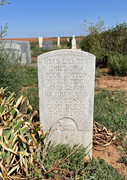He was buried in a small cemetery at the locality of Sardis, which is just a few miles west of Roby, among the gently rolling cotton fields of Fisher County, Texas. The death certificate simply listed the cause as "Premature birth." The doctor, a W.L. Allen, noted on the form that he had last seen the baby alive on the 8th -- probably upon having helped deliver him to his mother Minnie and her husband Homer.
Seeing that the cemetery was about 28 miles from my home in Sweetwater, I hopped in the truck and headed north to the burying ground, just north of Highway 180 a mile or less and not far from the Rolling Hills Quail Research Foundation whose work I am fond of.
At 3:30 on this sunny afternoon of the last day of summer, I was well aware of the 98-degree heat, but it lacked the malice of so many previous days this past couple of months. The cemetery of approximately 150 souls dates to 1898, and someone is taking reasonable care of it mowing to keep the mesquite from getting a foothold. It is still in active use by local families whose DNA is part of the soil here.
Working in a grid pattern, I looked as hard and as carefully as I could, but found no trace of a marker with "Infant Son Robertson" on it, although I found several graves of other babies. "Stillborn," said one. Three of them bore the carved lamb motif so sweetly used on the gravestones of babies and young children in late Victorian times and into the 20th century. As I was ready to leave, I passed a white marble stone cut in the shape normally issued for veterans.
When I walked past and turned around to read the inscription, I found words that cut right to my heart. Some saint had gone to the trouble and expense to mark this "tomb of the unknown child." Perhaps it was an infant boy, name of Robertson, who never had a chance ...

